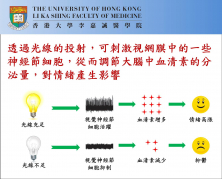Media
HKU finds increasing Y-type retinal ganglion cells activities induced by
light can help improving depression symptoms
17 Apr 2013
Situated in a place with ample light could ease one’s mind, as well as improving depression. The Department of Anatomy of The University of Hong Kong Li Ka Shing Faculty of Medicine, The State Key Laboratory of Brain and Cognitive Sciences in collaboration with The Peking University firstly reveals the reasons behind. Their study discovers that increasing activity of Y-type retinal ganglion cells induced by sufficient light can innervate a region of the brain named “Dorsal Raphe Nucleus” (DRN), which is an area controlling and uplifting one’s mood. This process works in a manner similar to antidepressant drugs to improve mood in depressed individuals. Thus, it proves that optic nerve can regulate mood. The results of their study have been published lately in an international scientific journal named Neuropsychopharmacology.
One of the key researchers of the study, Professor So Kwok-fai, Jessie Ho Professor in Neuroscience, Chair Professor of the Department of Anatomy, The University of Hong Kong Li Ka Shing Faculty of Medicine says, “The study broadens medical profession’s understanding of affective visual information processing, and suggests that a specific circuit that links the eye to the brain can affect mood through the similar mechanism as antidepressant drugs, posting a positive impact to one’s mood.”
Research methods and findings
The study is collaboratively conducted by researchers from the Department of Anatomy of The University of Hong Kong Li Ka Shing Faculty of Medicine and The Peking University on how lights could affect the Y-type retinal ganglion cells, thus innervating a mood regulating region of the brain called “Dorsal Raphe Nucleus” (DRN). Researchers keep Mongolian gerbils in a dark area to observe and analyse their response. It shows that when lights are absent, nerve-cell projections from the retina to the DRN will be blocked, leading to depressive-like behavior. Animals’ depressive symptom is measured through different behavioral tests, such as forced swimming test and tail suspension test. It shows that the immobile score of the light deprived group is significantly higher than normal group, which means light deprivation could induce depression. Besides, when lights are blocked, it will lower the concentration level of brain chemical, serotonin. Serotonin is functionally used to regulate mood in brain. The most commonly used antidepressant drugs, specific serotonin reuptake inhibitors (SSRIs) are drugs to regulate mood in a similar mechanism by increasing the level of serotonin inside the brain. In addition, through pharmacology means to increase the activity of the Y-type retinal ganglion cells, the depressive-like behavior of the gerbils could be reduced. This mechanism is similar to the function of antidepressant drugs to regulate mood.
Research Implications
This is the first-ever study which proves that light stimulation to “Dorsal Raphe Nucleus” (DRN) via direct projection from Y-type retinal ganglion cells can modulate the level of brain chemical, serotonin, thus controlling the mood of gerbils. As the mood regulating mechanism of gerbils is similar to that of human, “Dorsal Raphe Nucleus” is also an area inside human’s brain which is responsible for mood regulation. Thus, the above results can be applied to human. Lights can stimulate the production of serotonin to regulate emotion.
The study can deepen the understanding of affective visual information processing, and reveals that a specific circuit that links the eye to the brain can affect mood by regulating the neurotransmitter secretion. This would be an important theory and support to develop new therapy for depression.
About the research team
The study involves researchers from The University of Hong Kong Li Ka Shing Faculty of Medicine, The Peking University and The University of Nebraska Plant Pathology. It is financially supported by funding from National Natural Science Foundation of China, The Research Grants Council and National Institutes of Health in USA.
Please visit the website at http://www.med.hku.hk/v1/news-and-events/press-releases/ for press photos.
Professor So Kwok-fai, Jessie Ho Professor in Neuroscience, Chair Professor of the Department of Anatomy, The University of Hong Kong Li Ka Shing Faculty of Medicine says that the study broadens medical profession’s understanding of affective visual information processing.


